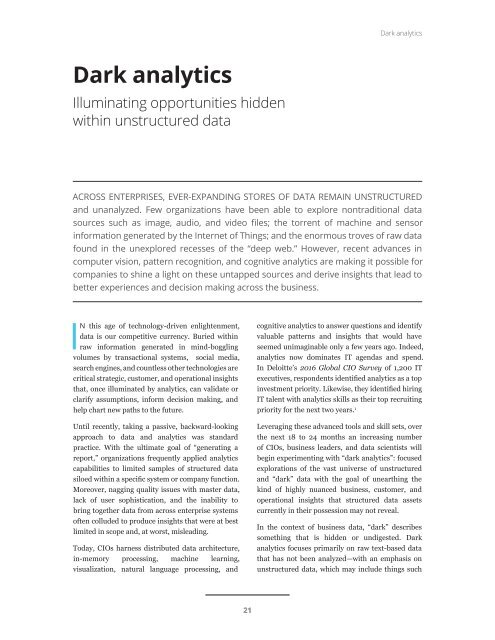Trending the trends Eight years of research
2kcf8xh
2kcf8xh
Create successful ePaper yourself
Turn your PDF publications into a flip-book with our unique Google optimized e-Paper software.
Dark analytics<br />
Dark analytics<br />
Illuminating opportunities hidden<br />
within unstructured data<br />
ACROSS ENTERPRISES, EVER-EXPANDING STORES OF DATA REMAIN UNSTRUCTURED<br />
and unanalyzed. Few organizations have been able to explore nontraditional data<br />
sources such as image, audio, and video files; <strong>the</strong> torrent <strong>of</strong> machine and sensor<br />
information generated by <strong>the</strong> Internet <strong>of</strong> Things; and <strong>the</strong> enormous troves <strong>of</strong> raw data<br />
found in <strong>the</strong> unexplored recesses <strong>of</strong> <strong>the</strong> “deep web.” However, recent advances in<br />
computer vision, pattern recognition, and cognitive analytics are making it possible for<br />
companies to shine a light on <strong>the</strong>se untapped sources and derive insights that lead to<br />
better experiences and decision making across <strong>the</strong> business.<br />
IN this age <strong>of</strong> technology-driven enlightenment,<br />
data is our competitive currency. Buried within<br />
raw information generated in mind-boggling<br />
volumes by transactional systems, social media,<br />
search engines, and countless o<strong>the</strong>r technologies are<br />
critical strategic, customer, and operational insights<br />
that, once illuminated by analytics, can validate or<br />
clarify assumptions, inform decision making, and<br />
help chart new paths to <strong>the</strong> future.<br />
Until recently, taking a passive, backward-looking<br />
approach to data and analytics was standard<br />
practice. With <strong>the</strong> ultimate goal <strong>of</strong> “generating a<br />
report,” organizations frequently applied analytics<br />
capabilities to limited samples <strong>of</strong> structured data<br />
siloed within a specific system or company function.<br />
Moreover, nagging quality issues with master data,<br />
lack <strong>of</strong> user sophistication, and <strong>the</strong> inability to<br />
bring toge<strong>the</strong>r data from across enterprise systems<br />
<strong>of</strong>ten colluded to produce insights that were at best<br />
limited in scope and, at worst, misleading.<br />
Today, CIOs harness distributed data architecture,<br />
in-memory processing, machine learning,<br />
visualization, natural language processing, and<br />
cognitive analytics to answer questions and identify<br />
valuable patterns and insights that would have<br />
seemed unimaginable only a few <strong>years</strong> ago. Indeed,<br />
analytics now dominates IT agendas and spend.<br />
In Deloitte’s 2016 Global CIO Survey <strong>of</strong> 1,200 IT<br />
executives, respondents identified analytics as a top<br />
investment priority. Likewise, <strong>the</strong>y identified hiring<br />
IT talent with analytics skills as <strong>the</strong>ir top recruiting<br />
priority for <strong>the</strong> next two <strong>years</strong>. 1<br />
Leveraging <strong>the</strong>se advanced tools and skill sets, over<br />
<strong>the</strong> next 18 to 24 months an increasing number<br />
<strong>of</strong> CIOs, business leaders, and data scientists will<br />
begin experimenting with “dark analytics”: focused<br />
explorations <strong>of</strong> <strong>the</strong> vast universe <strong>of</strong> unstructured<br />
and “dark” data with <strong>the</strong> goal <strong>of</strong> unearthing <strong>the</strong><br />
kind <strong>of</strong> highly nuanced business, customer, and<br />
operational insights that structured data assets<br />
currently in <strong>the</strong>ir possession may not reveal.<br />
In <strong>the</strong> context <strong>of</strong> business data, “dark” describes<br />
something that is hidden or undigested. Dark<br />
analytics focuses primarily on raw text-based data<br />
that has not been analyzed—with an emphasis on<br />
unstructured data, which may include things such<br />
21


